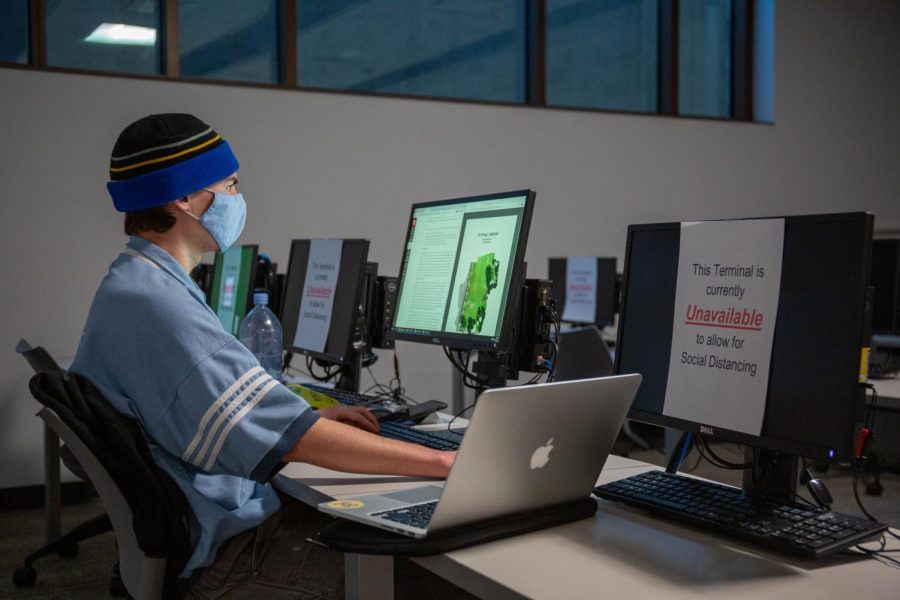Mendenhall: The U Should Make COVID-19 Era Class Flexibility Permanent
Fourth-year student, Thomas Stone, works on a GIS project at a computer lab in Gardener Commons on October 30, 2020. (Photo by Gwen Christopherson | The Daily Utah Chronicle)
March 25, 2022
The University of Utah was greatly impacted by COVID-19, so there were several changes made to mitigate high numbers of positive cases. Social gatherings were limited and in-person classes were reduced. As a result, the U decided to implement new tools and safety measures to tackle these sudden changes, such as vaccine requirements and hybrid classes.
Likely the biggest requirement the U put into place was the vaccine mandate for students and faculty for the spring 2022 semester. Students would have a hold placed on their accounts if they weren’t compliant. Compliance status was determined when a student is either fully vaccinated or had submitted an exemption. Exemptions can be submitted due to personal, medical or religious reasons. Within these changes, the U should continue to prioritize class flexibility. Many of these safety measures are now hindering our academic progress instead of helping.
The U made the decision to move the majority of classes online throughout the 2020-21 school year. Beginning the fall 2021 semester, in-person classes restarted, although hybrid-style classes were extremely popular among students. Hybrid classes integrated a mixture of online teaching (usually via Zoom) and in-person lectures. This class format allowed flexibility in the case of a COVID-19 case spike, and let students choose which class format they were most comfortable with. This was a great option that the U provided for their immunocompromised students. High-risk individuals were still able to benefit from classes that catered to both in-person and Zoom formats.
This accommodation was nice, but now things are beginning to return to normal. As a result, certain classes are becoming hard to access. As a full-time student that also works full-time, I can’t attend an in-person class more than one day a week. For example, there is a math class that I need in order to graduate, and it hasn’t been offered online since I started college in 2020. I have tried to enroll in it over the summer, but it still isn’t offered.
I prefer in-person classes, but I’ve become accustomed to Zoom classes due to hybrid-style classroom settings. Because of this comfortability with hybrid classes, my school schedule works around my job. Now that they are becoming harder to access, it’s difficult to get classes that fit into my full schedule. The flexibility of hybrid classes seems to be dwindling for those who have relied on hybrid/online classes for the last two years.
From a professor’s perspective, this shift to hybrid learning was both good and bad. Professors could choose an online or in-person class format. Personally, I had a few professors who loved keeping their in-person classes throughout spring 2021. They only moved them online if there was any kind of COVID-19 exposure. Conversely, I also had professors who decided not to teach classes of 100+ students in-person and made the decision to host bi-weekly Zoom meetings. Whatever the case may be, professors and universities are now better equipped to handle large-scale issues that prevent students from attending in-person classes.
However, some professors reported that utilizing so much technology during these online class sessions just wasn’t worth the anxiety and exhausting technical errors. Throughout the majority of my classes in 2020 and 2021, those that were in-person were also recorded or live streamed at the same time. This combined with technological errors made hosting multiple forms of class a nightmare. There were many times that a class would be delayed for 15 minutes just so online accommodations could be made.
In addition to classroom changes, there have also been several campus-wide changes that affect each student and faculty member at the U. Some of these changes include vaccine requirements and mask mandates. The vaccine requirement is relatively new to us on campus. It just recently took effect in spring 2022, although announcements of the change were sent to faculty and students throughout the fall 2021 semester.
Another temporary change has been the utilization of mask mandates on campus. Mask mandates have been all over the place since Fall 2020. They have been suggested, required, taken away and reinstated several times throughout this school year. We’re beginning to see lots of backlash and pushback about some of these inconsistencies in the last several months. Health and safety measures both state- and nation-wide have bounced back and forth for months, and can oftentimes be confusing. Federal and local guidelines can vary and contradict one another.
At the end of the day, the U isn’t perfect. As individuals, we each want something different, and that can’t always be catered to. However, the U should keep the flexibility and class availability for both students and professors. This hybrid year of 2021-22 has been interesting, to say the least. It’s safe to say that the U is likely using this as a trial run of what might become a more permanent change in future years.









J • Mar 29, 2022 at 1:32 pm
The U is a commuter school. Having classes available via zoom (or equivalent) allows students to attend lectures even if they live far away from campus. Additionally, it enables students to attend lectures while they commute to school. I personally believe that having professors stream in-person classes offers a perfect balance for students to choose their preferred learning method.
Casey • Mar 29, 2022 at 12:23 pm
I appreciate having flexibility. I’m sure most professors didn’t like online learning, so I would say they should teach in person, but for the ones who didn’t mind, let them teach the hybrid classes. They are very beneficial for those who have to work